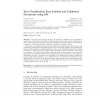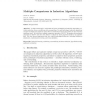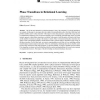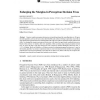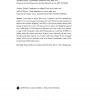118
click to vote
ML
2000
ACM
15 years 6 days ago
2000
ACM
This paper shows that the accuracy of learned text classifiers can be improved by augmenting a small number of labeled training documents with a large pool of unlabeled documents. ...
75
Voted
ML
2000
ACM
15 years 6 days ago
2000
ACM
102
click to vote
ML
2000
ACM
15 years 6 days ago
2000
ACM
Twenty-two decision tree, nine statistical, and two neural network algorithms are compared on thirty-two datasets in terms of classification accuracy, training time, and (in the ca...
79
Voted
ML
2000
ACM
15 years 6 days ago
2000
ACM
Abstract. A single mechanism is responsible for three pathologies of induction algorithms: attribute selection errors, overfitting, and oversearching. In each pathology, induction ...
106
Voted
ML
2000
ACM
15 years 6 days ago
2000
ACM
We present an approach to inductive concept learning using multiple models for time series. Our objective is to improve the efficiency and accuracy of concept learning by decomposi...
140
click to vote
ML
2000
ACM
15 years 6 days ago
2000
ACM
One of the major limitations of relational learning is due to the complexity of verifying hypotheses on examples. In this paper we investigate this task in light of recent publishe...
ML
2000
ACM
15 years 6 days ago
2000
ACM
Capacity control in perceptron decision trees is typically performed by controlling their size. We prove that other quantities can be as relevant to reduce their flexibility and co...
86
Voted
ML
2000
ACM
15 years 6 days ago
2000
ACM
In this paper we present TDLEAF( ), a variation on the TD( ) algorithm that enables it to be used in conjunction with game-tree search. We present some experiments in which our che...
106
click to vote
ML
2000
ACM
15 years 6 days ago
2000
ACM
Existing methods for exploiting awed domain theories depend on the use of a su ciently large set of training examples for diagnosing and repairing aws in the theory. In this paper,...
ML
2000
ACM
15 years 6 days ago
2000
ACM
Bagging and boosting reduce error by changing both the inputs and outputs to form perturbed training sets, grow predictors on these perturbed training sets and combine them. A que...
